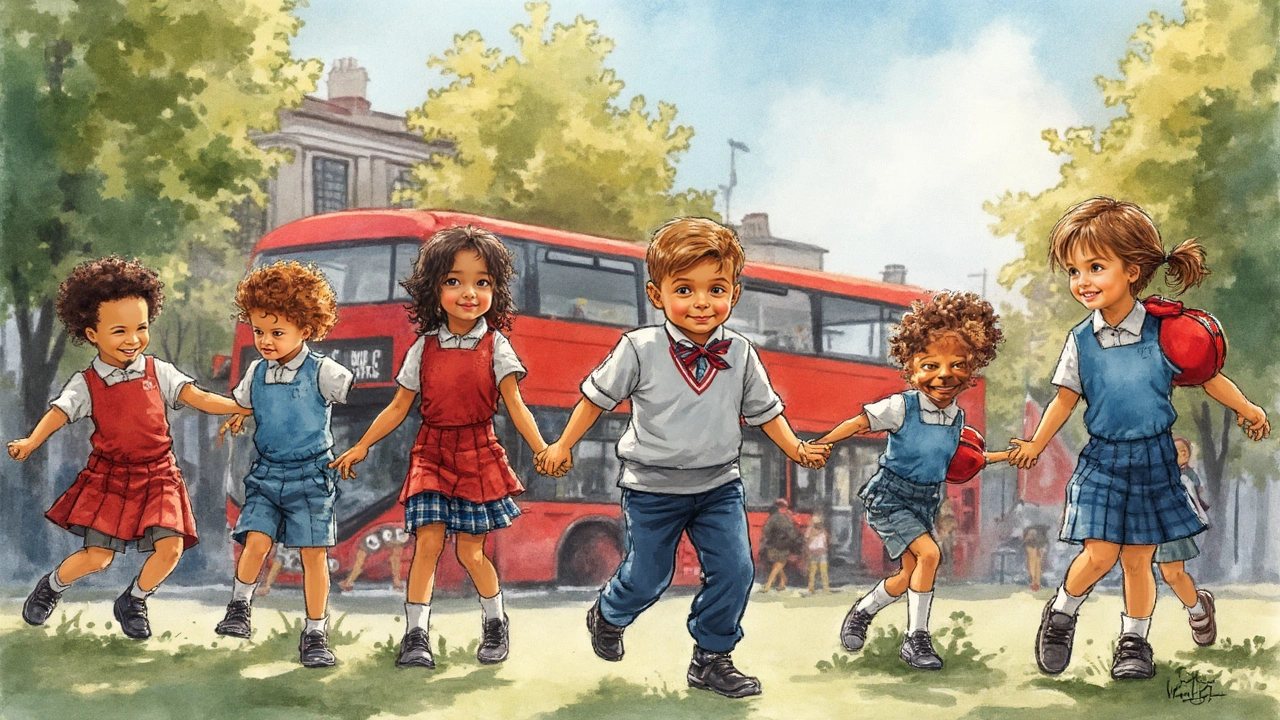
If your child suddenly starts making odd twisting movements or facial grimaces that weren’t there before, it can freak you out. You might wonder if it's a habit, a sign of stress, or something much bigger. Dyskinesias—the fancy name for abnormal, involuntary movements—can show up in kids for all sorts of reasons. Some kids might flap their arms, twitch, or grimace without being able to stop. This isn’t just a quirk, and it’s definitely not your kid’s fault.
You probably have a ton of questions and worries. What’s actually going on? Is this going to get worse? Are there ways to help? The truth is, dyskinesias are more common in kids than most people think, and they don’t always mean something sinister. Still, figuring out what’s causing these movements matters, because it can point to things like medication side effects, neurological issues, or even something temporary. Knowing what to watch for and when to take action can make a big difference. Let’s unpack what these movements mean and what you, as a parent, can do right now.
- What Are Dyskinesias and How Do They Show Up in Kids?
- Why Do Dyskinesias Happen?
- Common Triggers and What Makes Them Worse
- When to Seek Medical Advice
- Tips for Parents: Helping Kids Live Better with Dyskinesias
What Are Dyskinesias and How Do They Show Up in Kids?
Dyskinesias are basically movements your kid can’t control, and they’re not the usual fidgeting or play. These movements can be sudden or slow, and sometimes look a bit unusual or even scary if you’re not expecting them. In kids, dyskinesias cover everything from random twitching and writhing to fast blinking or weird neck movements.
The types of dyskinesias most kids get include:
- Chorea: Jerky, dance-like movements. These are quick and jumpy—think of someone unable to keep still for a second.
- Dystonia: Muscles pull or twist uncontrollably. You might see toes curling or a head turned to the side and staying there.
- Myoclonus: Rapid muscle jerks, like a sudden shock or jolt. Sometimes it looks like your child is startled for no reason.
- Tics: Sudden, repetitive sounds or movements. Kids might grunt, blink, or shrug over and over.
Don’t confuse these with seizures—they aren’t the same thing. Kids with dyskinesias know the movements are happening, but they can’t control them. Sometimes, the movements get worse when a kid is tired, anxious, or excited. If you notice these out of the blue or they’re going on for more than a few days, don’t ignore it.
Here's a quick way to see how varied these movements can be:
| Type | What It Looks Like |
|---|---|
| Chorea | Jerky, unpredictable arm or leg flailing |
| Dystonia | Twisted or stuck body parts |
| Myoclonus | Sudden jolts in muscles |
| Tics | Repeated blinking or noises |
Spotting dyskinesias in children early can help get to the bottom of what’s causing them. If your kid’s teachers or coaches mention strange movements or you catch repeated, odd patterns, it’s worth paying attention. These are not just habits; they deserve a closer look.
Why Do Dyskinesias Happen?
If you’re dealing with dyskinesias in your child, you’re probably wondering what actually causes these weird movements. The answer is, it’s not simple. There are a bunch of reasons a kid can end up with movement disorders like this, and it’s not always easy to spot the cause at first glance.
For a lot of kids, the problem starts in the brain, especially in areas that control movement, like the basal ganglia. When those nerve circuits don’t fire correctly, you get those awkward, unpredictable movements. Sometimes these pathways get messed up because of genetic conditions. A good example: conditions like cerebral palsy or certain rare gene mutations can make dyskinesias much more likely.
Medications can be another big factor. Some of the drugs used to treat things like epilepsy, ADHD, or even mental health issues can cause dyskinesias as a side effect. The classic example is a group of medicines called antipsychotics—these can trigger tardive dyskinesia, which causes repetitive, jerky movements, especially in the face or tongue.
And then, there are cases where infections or injuries mess with the brain. For example, a really high fever or a viral infection like encephalitis can sometimes touch off these movements for a while, though usually they fade after the illness passes. Rarely, a head injury can be behind it, especially if the child hurt the part of the brain that handles movement.
Sometimes, kids develop dyskinesias as a reaction to stress or as part of a psychological issue, but that’s a lot less common than the causes above. Still, a doctor will want to check for everything and rule out physical triggers first.
- Genetic disorders (e.g., cerebral palsy, rare mutations)
- Medication side effects (especially antipsychotics, some epilepsy drugs)
- Brain infections or injuries
- Metabolic or chemical imbalances (like low calcium or magnesium)
Here’s a quick look at how common some causes are:
| Cause | Estimated % of Pediatric Cases |
|---|---|
| Medication side effects | 15-20% |
| Genetic or developmental | 30-40% |
| Infections or injury | 10-15% |
| Metabolic issues | 5% |
| Unknown/Other | 25-30% |
The bottom line? There’s no one-size-fits-all answer. If you spot strange movements in your kid, jot down when they happen and what’s going on around them. That info can really help the doctor narrow down the cause and find the right help.

Common Triggers and What Makes Them Worse
With dyskinesias in children, certain triggers can crank up the movements, making daily life tougher for both kids and parents. Medications are right at the top of the list. Some drugs used for things like epilepsy, ADHD, or even nausea can mess with how the brain controls movement. A lot of kids develop dyskinesias as a side effect of antipsychotic meds or certain anti-seizure drugs. Even stopping a medication too suddenly can cause things to flare up.
Another biggie is stress. Kids who feel anxious, overwhelmed, or even just super excited might have more noticeable movements. Sometimes, even just being tired or skipping meals can make symptoms more obvious. Did you know that lack of sleep can double the intensity of dyskinesias? That’s why bedtime actually matters here.
Some triggers are sneaky. Fast changes in temperature, especially moving from a hot playground to an air-conditioned room, can set things off for certain kids. Viral infections, like the common cold or flu, have also been linked with movement changes. Even certain foods—like ones with high sugar or caffeine—might not directly cause dyskinesias, but they can make kids jittery, which can sometimes make movements worse.
- Medication changes – starting, changing, or stopping meds can trigger movements
- Stress and strong emotions – worry, excitement, or even frustration
- Fatigue – being overtired makes symptoms stand out
- Illnesses – colds, fevers, and infections can all add fuel to the fire
- Sudden environmental changes – temperature shifts or very loud noises
Here’s one thing many parents don’t expect: sometimes trying to stop the movement only makes it worse. The harder a child tries to control it, the longer it drags on. It helps to focus on patterns and note what sets things off. Keep a simple diary of triggers and symptoms for a week or two. Bring this to your next doctor appointment, and you’ll save a ton of “guesswork” time.
When to Seek Medical Advice
It’s easy for parents to second-guess themselves, but if you see strange, repetitive movements in your kid, it’s smart to talk to a doctor—not just hope they’ll grow out of it. Some dyskinesias can be harmless ticks or habits, but others signal something bigger is going on in the brain or nervous system.
Here’s when you shouldn’t wait:
- The movements last more than a few days or keep getting worse.
- Your child seems to have trouble with daily stuff—like walking, eating, or talking—because of the movement disorder.
- There’s a sudden change, like a fever, confusion, weakness, or trouble waking up. Those are red flags.
- Your kid just started a new medication (especially for things like ADHD or epilepsy). Some meds trigger dyskinesias.
- You see jerky movements right after a head bump or injury.
- There’s a family history of unusual movement disorders.
Pediatricians see dyskinesias come and go, but if anything feels off or you’re worried, get checked out. It’s not wasting anyone’s time. Early help can nip bigger problems in the bud. Neurologists have cool tests and scans that can pinpoint what’s behind the scenes—sometimes it’s as simple as changing a medicine or treating an infection.
Sometimes spotting a pattern helps. Keep a simple log of when movements happen, what your child was doing, and how long they lasted. This gives doctors way more clues than you’d think.
| Red Flag Symptom | Recommended Action |
|---|---|
| Sudden onset after new medication | Call the doctor right away |
| Changes in speech or ability to move | Go to the ER |
| Movements disrupt sleep or school | Book a pediatrician or neurologist visit |
| Loss of consciousness | Call 911 or go to the ER |
Bottom line: when your gut says something’s off with your kid’s movements, it’s better to have a professional take a look. Trust your instincts and push for answers if you need them.

Tips for Parents: Helping Kids Live Better with Dyskinesias
Getting a handle on dyskinesias in kids isn’t just about doctor visits and meds. Daily life matters too. Here are some down-to-earth ways to make things easier for you and your child.
- Keep a Movement Journal: Jot down when the movements happen, how long they last, and what your kid was doing before they started. Noting things like missed meals, stress, or lack of sleep can help pinpoint triggers. Doctors love having these details because it saves a ton of time during appointments.
- Be Honest with Teachers and Caregivers: Don’t hide what's going on. Give caregivers and teachers a heads-up so they know what to expect. You’ll worry less about misunderstandings or your child being picked on.
- Normalize Conversation at Home: Let your kid ask questions and talk openly. Kids often think they're doing something wrong. Reassure them that dyskinesias are outside their control and not their fault.
- Create Friendly Routines: Regular meals, hydration, and enough sleep can sometimes lessen dyskinesias. Try calming activities like stretching, slow walks, or deep breathing if you spot a pattern between stress and movements.
- Talk to the Doctor about School: If movements get in the way at school, ask your neurologist about a "504 Plan". It’s a legit way to get your kid extra help or small classroom adjustments.
Need a reality check? According to the Child Neurology Foundation, about 1 in 8 kids with a neurological disorder experiences some form of abnormal movement like dyskinesias. It isn’t rare, so you’re definitely not alone in this.
| Practical Tips | Why It Helps |
|---|---|
| Movement Journal | Helps track patterns and triggers |
| Teacher Involvement | Reduces stigma and improves support |
| Consistent Bedtime | Reduces potential triggers from tiredness |
| Hydration | Keeps the body balanced, sometimes limits symptoms |
One last tip: push for a team approach. Get your neurologist, teachers, physical therapist, and—most important—your child on board. The more everyone knows, the smoother things get. Life with dyskinesias isn’t always easy, but a few little tweaks can make it a whole lot less overwhelming.


This article definitely brings some much needed clarity about dyskinesias in kids, something not many parents might be familiar with. The breakdown of different types and symptoms is especially helpful because these movement disorders can be so confusing and varied.
What I appreciate most is the attention to daily life impact; often medical info skips over that practical side. Parents need to understand how these episodes might affect things like school or play.
I'm curious if the article touched on any recent advances in treatment or therapy strategies? Because managing dyskinesias isn’t just about diagnosis – it’s about ongoing support.
Overall, it is a solid resource for parents navigating this complicated situation. Thanks for sharing!
Honestly, I find a lot of these so-called "helpful" articles to be overly simplistic and sometimes misleading. They pick a few obvious symptoms, slap a neat label on it, and suddenly every kid twitch is dyskinesia?
The spectrum of movement disorders is HUGE, and real diagnosis takes much more nuanced assessment than a quick parent primer. I doubt some parents actually get the whole complicated picture with just this article.
Plus, throwing around terms like "helpful tips" can be patronizing if they don't clarify that a specialist’s evaluation is irreplaceable. Parents don't need more guessing games.
Call me skeptical, but I'd want to see some clinical depth before saying this is truly empowering info.
Glenda, I get where you're coming from, but I think this article plays an important educational role in bringing awareness to something many might not even know exists in kids.
Not every piece needs to be a deep dive — sometimes a simple overview prompts parents to seek proper evaluation sooner. Early intervention can make a world of difference.
That said, yes, it should emphasize that medical professionals are essential for diagnosis. Maybe they assume that?
It’s a balancing act between not overwhelming parents and giving them enough info.
Oh my god, I literally can't even imagine the stress these poor families must go through! 😰 Dyskinesias in children sounds terrifying and heartbreaking. Like, watching your kid have involuntary movements and not knowing how to help them??
This article sounds like a lifesaver, honestly. Parents need to know when to worry and what steps to take. That's huge.
I wonder if they included info on emotional support? Because this kind of thing isn't just physical, it's emotionally draining. 💔
Plus, navigating medical appointments is a nightmare on its own, so any tips would be gold!
In a clinical context, dyskinesias manifest as involuntary, erratic, writhing movements which can often be mistaken for other neuromotor disorders. This article seems to effectively summarize these signs as they present in pediatric populations.
From a linguistic standpoint, clarity and accessibility appear prioritized here, which is imperative for non-specialist readers such as parents.
I am curious whether the article discusses pharmacological versus therapeutic management options and their relative efficacy, as this remains a contentious area with ongoing research.
Additionally, the emphasis on navigating medical appointments is commendable, as care coordination often poses a logistical challenge.
What intrigues me most about this topic is how cultural perceptions impact the parents' approach to movement disorders in children. In some communities, involuntary movements might be misinterpreted as behavioral issues or even spiritual afflictions, which complicates seeking proper diagnosis and treatment.
This article's practical steps could help bridge cultural gaps by informing parents what to expect medically rather than socially stigmatizing the condition.
Furthermore, I wonder how accessible specialist care is across various regions, especially in underserved populations? The article might benefit from addressing these disparities.
It’s essential to consider the holistic environment of the affected child.
While the basic premise of the article seems adequately comprehensive in delineating diverse dyskinetic phenomena in children, I posit that its utilization of layman language may truncate the intricate pathophysiological nuances inherent in such disorders.
It behooves us, therefore, to critically appraise the didactic efficacy of such literature insofar as it succeeds in both enlightening the layperson and refraining from oversimplification that obfuscates the clinical complexity.
Moreover, the purported "surprising facts" ought to be evaluated for clinical veracity to avoid disseminating misconstrued information that might engender undue anxiety among caregivers.
In summation, caution is warranted when balancing accessibility against encyclopedic thoroughness.
This article seems like a useful guide. It's tough for parents dealing with this kind of unpredictable disorder to know when to be concerned and what their next steps should be.
Having practical advice means a lot, especially when emotions are running high. Parents need clarity and reassurance, not jargon.
If the article also provides ways to support the child emotionally and socially, then it's hitting the right notes.
Sometimes even small tips can make a huge difference in day-to-day life.
I've always felt that parents facing such difficult diagnoses need both knowledge and encouragement. Articles like this can serve as a beacon in overwhelming times.
I am especially interested in the suggested tips for navigating appointments — often underestimated but crucial for ensuring the child gets proper care.
Knowing how to prepare questions, track symptoms, and advocate effectively can empower families so much.
Does anyone know if it covers community resources or support groups? Connecting with others can be a vital part of coping.
Oh, the labyrinthine ordeal of comprehending and addressing childhood dyskinesias! Truly, it exposes the fragile veneer of parental preparedness when confronted with such mysterious neuromotor aberrations!!
This article seemingly attempts to distill a vast, entangled skein of clinical and psychosocial complexities into digestible morsels. But does it dare to scratch beneath the superficial gloss of symptomatology and practicalities, to probe the profound human anguish beneath?
Alas, one only hopes that amidst its tips for appointments and daily challenges, it imbues readers with not just knowledge, but the courage to face an uncertain horizon with unwavering resolve!!!
I found this article quite illuminating as someone who is learning about diverse neurological conditions. It clarifies how dyskinesias in children might be distinct from adult cases and highlights the importance of early recognition.
Being concise yet informative is a skill, and this piece seems to communicate complex ideas accessibly. I appreciate that it recognizes the parents’ role not only as caregivers but as advocates.
I'd be interested to see follow-up discussions about how different therapies impact children’s quality of life long-term.